The women’s football at the Olympics 2020 may have come to a conclusion, but the final two games provided us with plenty of drama and excitement. The bronze medal match pitted a USA side who have disappointed in this tournament against an Australian team that has yet to win a medal of any colour in Olympic women’s football, and were therefore looking forward to a chance to make history. This tactical analysis will look at the improvements in the USA’s performances, compared to their semi-final against Canada, as well as Australia’s tactical approach to the match and the errors that cost them a place on the podium.
Lineups

Following their defeat to Canada, the USA made five changes to their starting XI, reverting to a 4-3-3 to give them better balance across the whole team. Chicago Red Stars goalkeeper Alyssa Naeher injured her knee in that game, so Portland Thorns stopper Adrianna Franch, who replaced her during that match, started between the posts. Former Manchester City Women midfielder Sam Mewis came into the midfield, whilst head coach Vlatko Andonovski opted to name an experienced forward line in former Manchester United Women striker Christen Press, NY/NJ Gotham’s Carli Lloyd and OL Reign’s Megan Rapinoe, all of whom had made an impact from the bench against the Canadians.
Australia, who were beaten by Sweden in their semi-final, made one enforced change to their team, as Lyon Feminines’ Ellie Carpenter was suspended, following her red card in that game. Experienced Vittsjo GIK defender Clare Polkinghorne took her place on the right of the back three, whilst Chloe Logarzo and former West Ham United Women player Emily van Egmond continued their midfield partnership, and the now-familiar trio of Kyah Simon, Sam Kerr and Caitlin Foord once again started at the top.
The USA’s improvements
It is no secret that the USA were poor in this tournament, and the bronze medal is not what they would have wanted, nor what the fans would have expected. However, it was the only available prize left to them, and they clearly wanted to win it and go home with something.
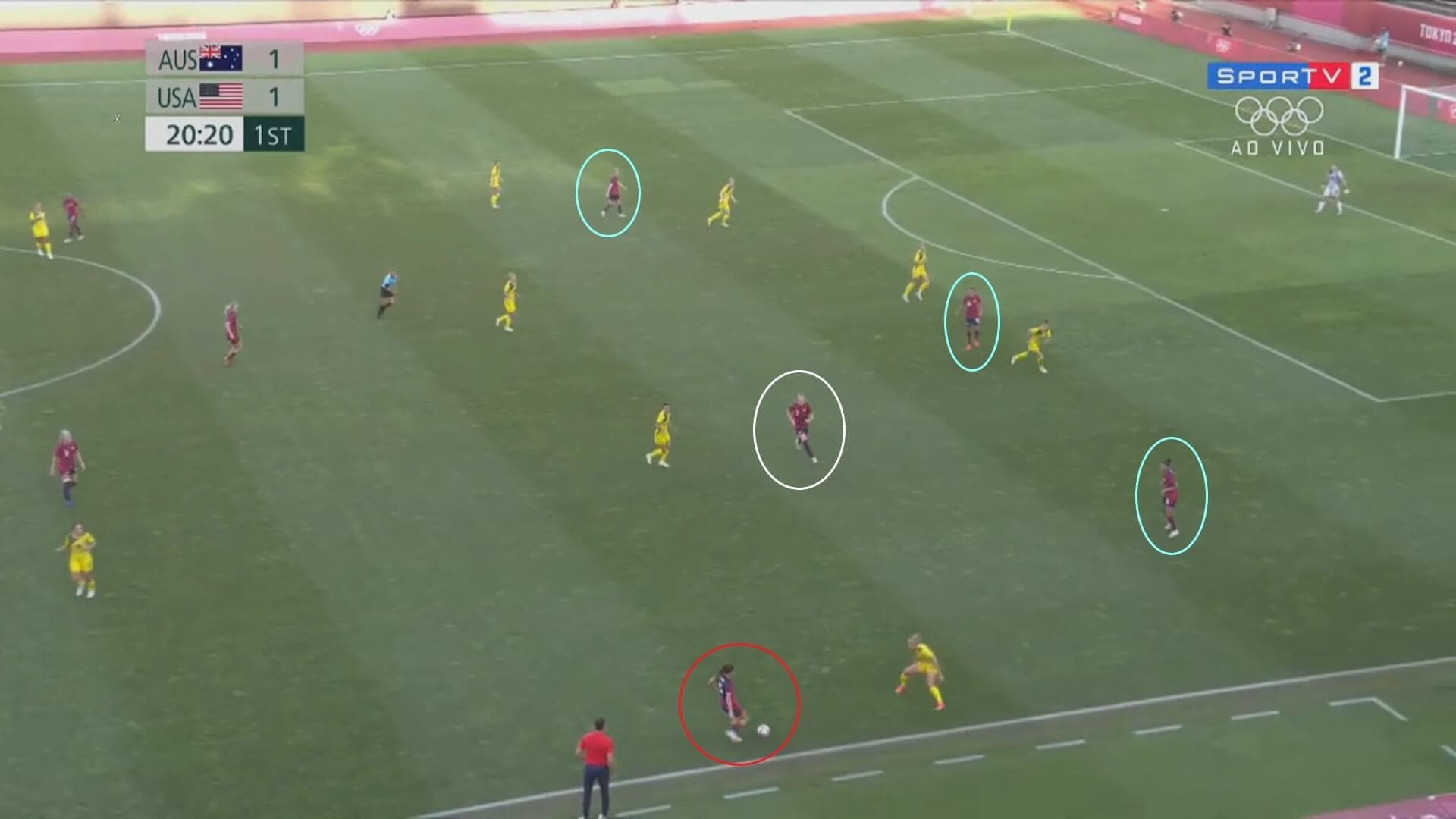
Having changed their entire front three in one go against Canada, Vlatko Andonovski hoped that the experience he had brought into this one would get the team on the front foot from the first whistle. Whilst that did happen, it was the addition of Sam Mewis that really made the difference, as this image shows. She tends to find spaces in front of the forward line, linking up play and helping her team to move the ball around the pitch. She also makes intelligent runs, which is why she was a key player for Manchester City last season. Here, she has come towards the ball, providing the shorter passing option, which allows the forwards to stay high and get between the defence, pinning them back.
With all of that in place, the space has opened up in front of the defence, allowing the USA to create a goalscoring opportunity. We know that one of the USA’s key tactics is to get players ahead of the ball to create multiple passing options, but this would be more difficult against a back five, as space would have been at a premium, so the intelligent movement and positioning of their attackers and midfielders was crucial to the USA finding gaps.
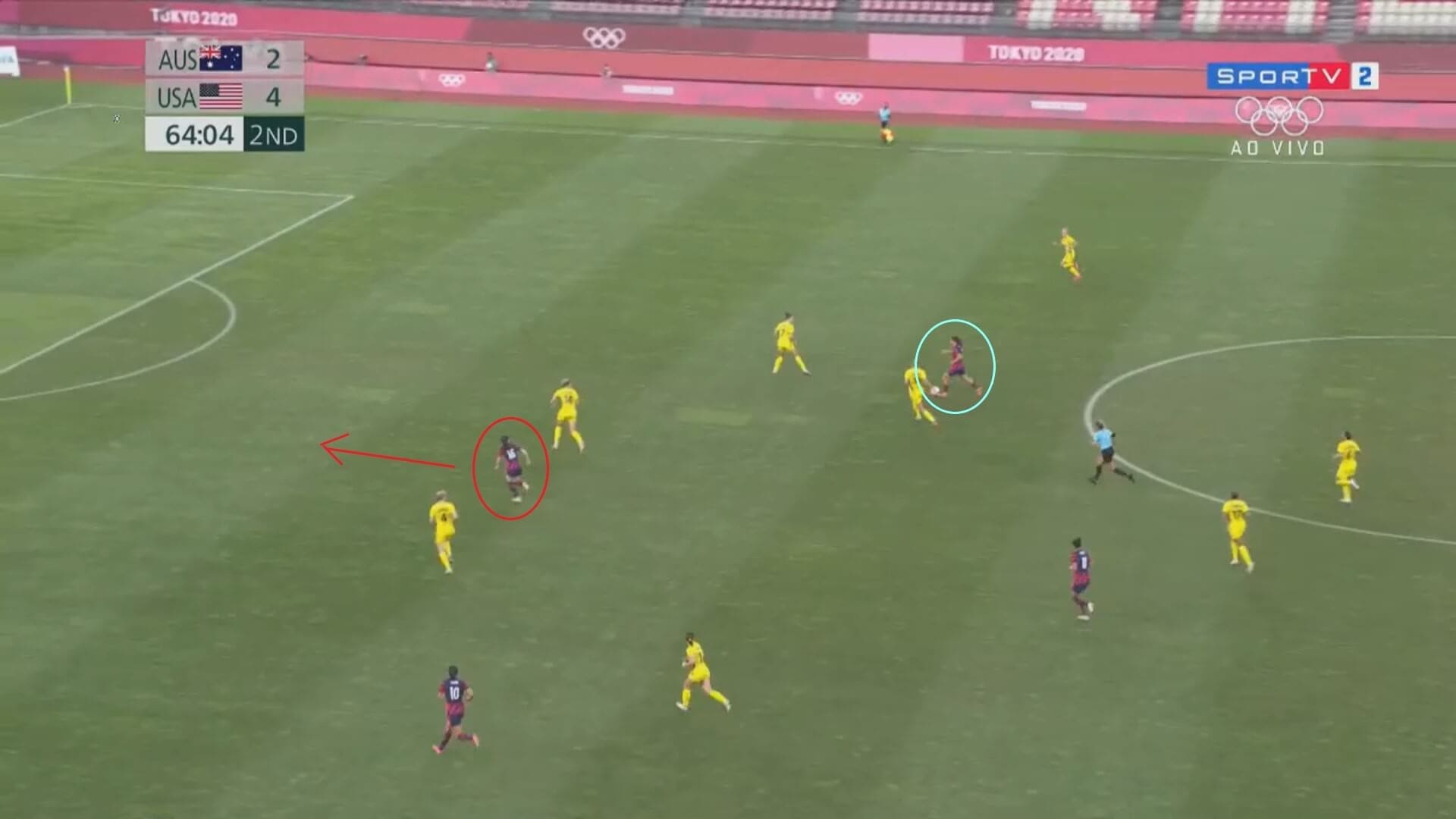
In the second half, their substitutes brought different qualities to the field, allowing them to continually adapt to what was happening at various times. For example, Sam Mewis relies on movement and control of the ball to have an effect on matches, whilst her replacement, Rose Lavelle, is more attack-minded, preferring to get forward and shoot at goal wherever possible. As a result, her arrival gave the USA an extra threat in the final third, again increasing their numbers and chances of scoring.
Here, the red arrow indicates Lavelle’s run through the defence, with Tobin Heath passing through to her behind the defensive line. Heath’s perfectly weighted pass demonstrates the composure that the USA had in the final third, which was missing against Canada, and their win in this game was their reward for this improvement in their play.
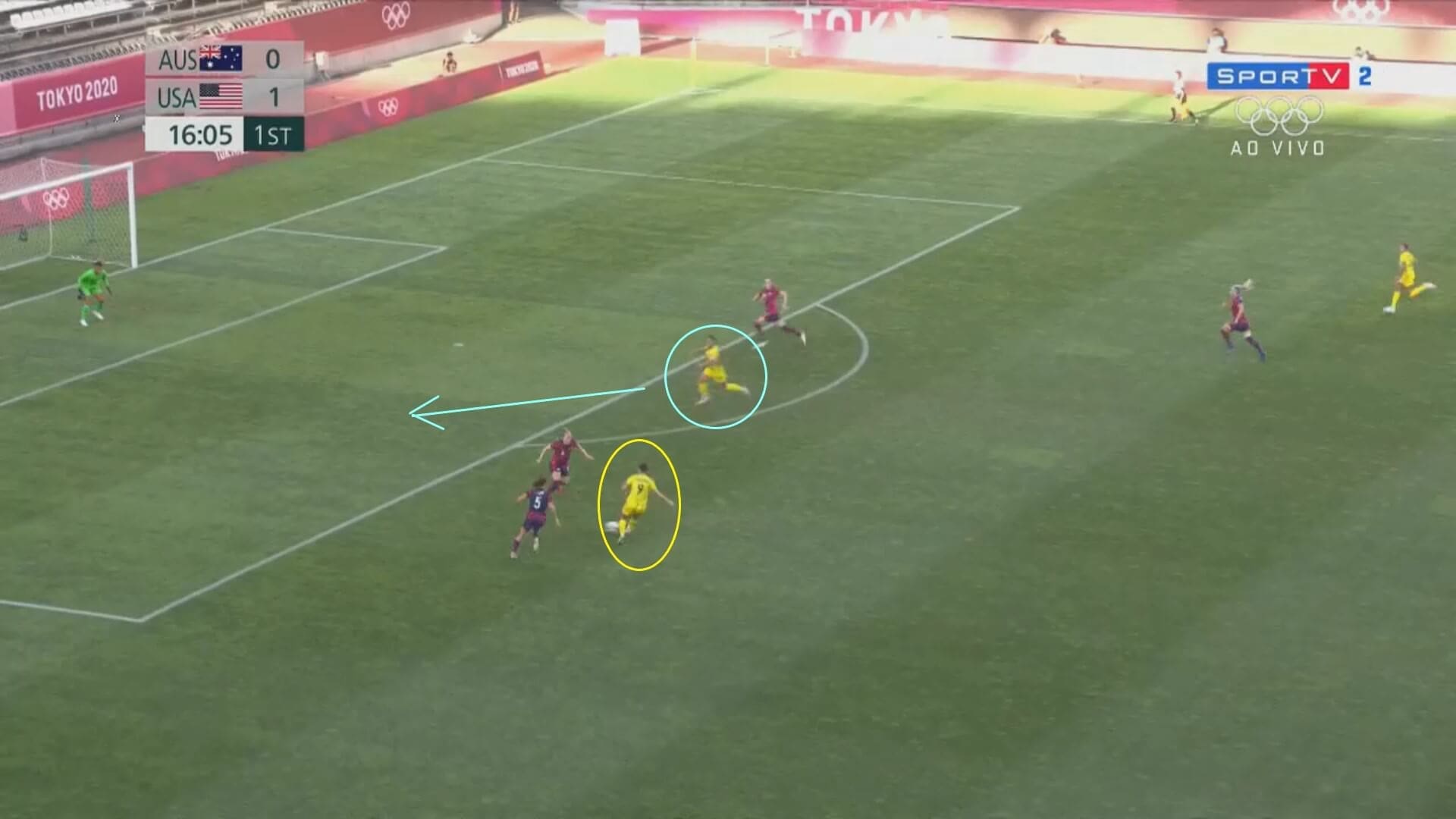
However, whilst we have discussed the improvements made by the USA in this game, we must also mention the continued problems they faced. Against Canada, their passing and quality with the ball was really poor, and it allowed their opponents to run at them and create opportunities in their third. Against Australia, that was still the case, and this image shows one time when the world champions were punished. Sam Kerr and Caitlin Foord have both come forward here, with the USA allowing both to play to their strengths, as Foord regularly links up with Netherlands striker Vivianne Miedema at Arsenal Women in this way, whilst Kerr can’t be given an inch of space to move into.
The combination of Foord’s passing ability and Kerr’s spatial awareness led to Australia scoring their first goal of the game from this chance, and this was not the only time that the USA gave possession away in a poor manner, so they do still need to have more care of the ball, but there were less careless passes than in the semi-final, which is a positive.
Australia’s tactics
Whilst the USA looked more like themselves, Australia had their own tactics in this game, trying to keep the USA thinking, as this analysis will now move on to.
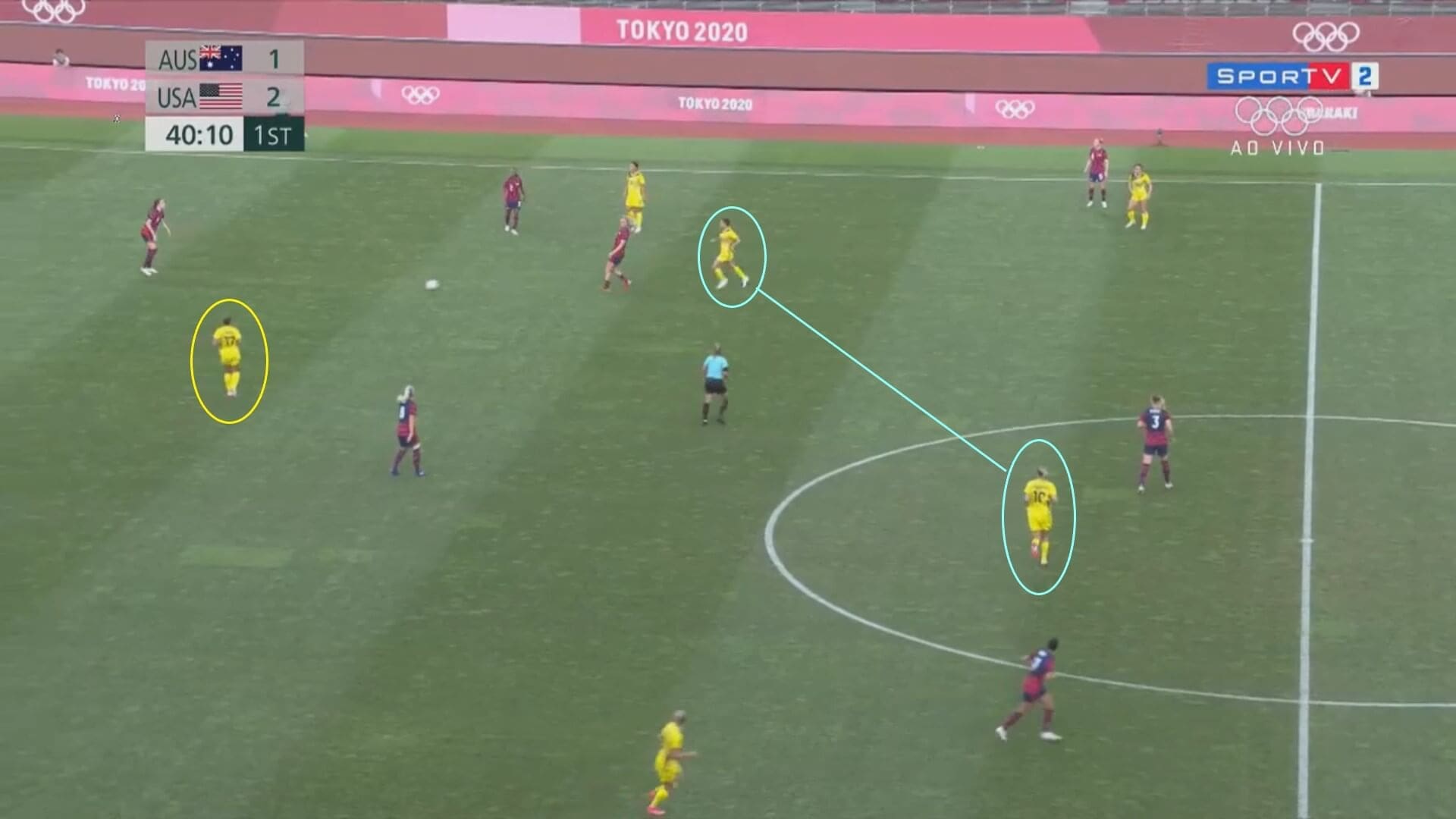
Australia had a different midfield system to the USA’s, with Emily van Egmond and Chloe Logarzo working together to cover all areas of the pitch. van Egmond tended to stay back and protect the defence, using her height to clear balls that came near them, whilst former Bristol City Women midfielder Logarzo was often seen in attacking positions in the opposition’s half.
As a result of their positioning and teamwork, Australia could also push their forwards as high up the pitch as possible. Logarzo’s presence meant that the three attackers didn’t need to drop back as often, ensuring Australia always had options in the final third when in possession.
What has been especially notable about Simon, Kerr and Foord in this tournament has been their movement around the pitch, never remaining in a fixed position. The intention of this is to keep defenders guessing, as they wouldn’t know whether to close down or stay back, meaning there is more chance of them being caught out. As the last image showed, when the USA did make a mistake in defence, the Australian attackers were there to punish them, and the three goals they scored are a testament to their clinical finishing when they did have these chances.

As a result of their organisation, Australia were able to compete with the USA’s star players, and this image shows one example of that happening. Megan Rapinoe has the ball on the far side wing, but is being closed down on both sides by opponents, as the yellow arrows show. This was particularly prominent in the early parts of the game, as Australia looked to limit the opportunities the USA created, ensuring their key players couldn’t affect the game. This was especially important against this particular USA front three, given the threat they pose when allowed to get behind opposing defences.
Having the aforementioned defensive protection undoubtedly helped with this, as Australia had players who could close the ball down from different directions. However, it was their constant awareness of the ball’s location that was the main reason for the USA’s initial struggles to get around them.
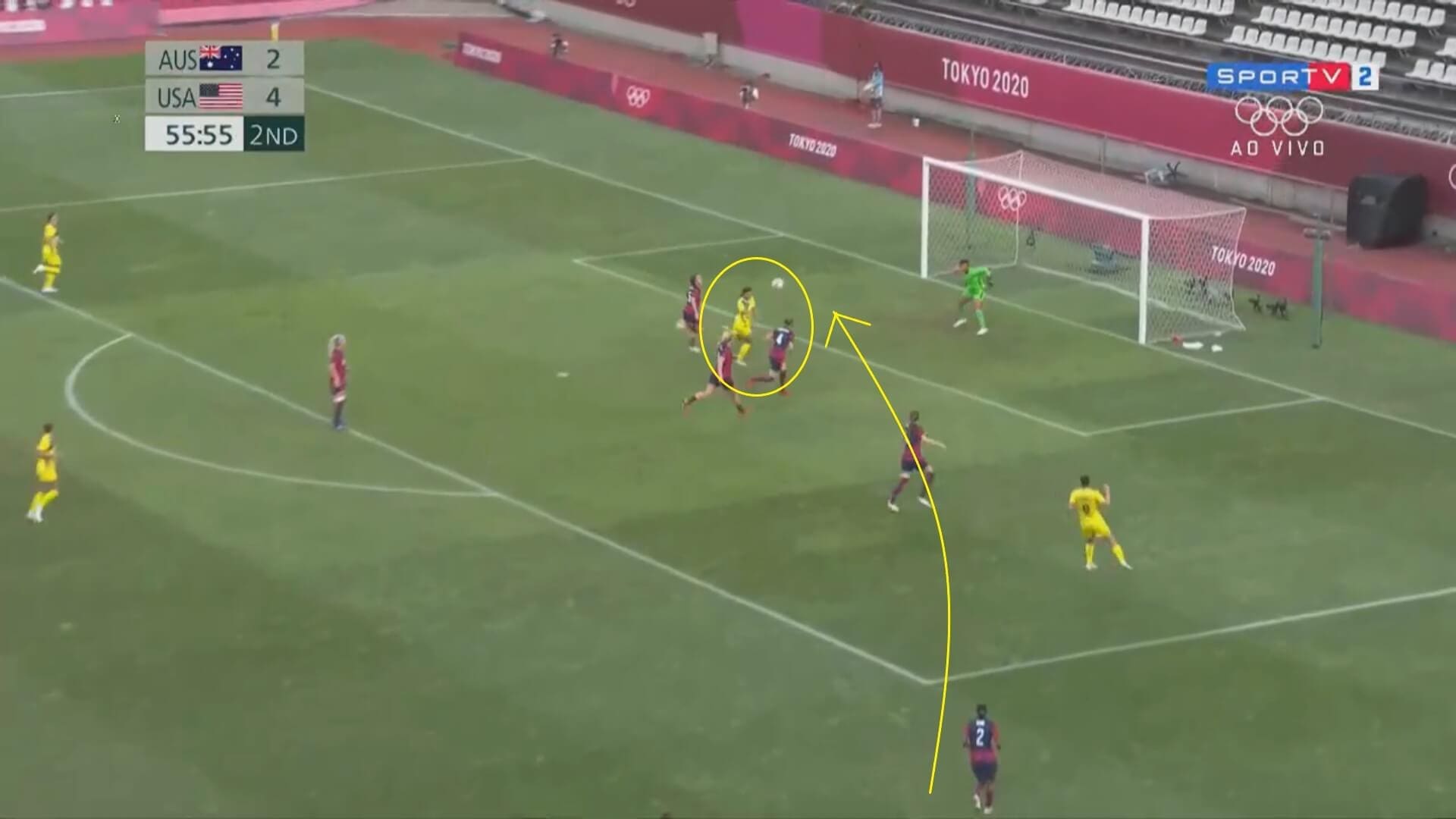
Having been 4-1 down at half-time, it was not surprising that Australia made some tactical changes in an effort to spark a comeback. We saw in the first half how they looked to play through the thirds and then move the ball into the box when in a good position. In the second half, however, more balls went into the box from further out, as this image shows. This meant that the USA had less time to set up defensively, thereby increasing the chances of Australia scoring.
This alteration was helped by Sam Kerr’s positioning, as she got into even more dangerous spaces and provided her teammates with a target to aim for with their crosses. Her positioning was crucial for Chelsea last season, and also proved to be the undoing of Team GB in the quarter-final match between the two sides, so we know that this gives Australia a greater chance of scoring. At this stage of the game, they needed to try different things to get back into the match, and this was one way that they looked to find a way through the USA’s backline.
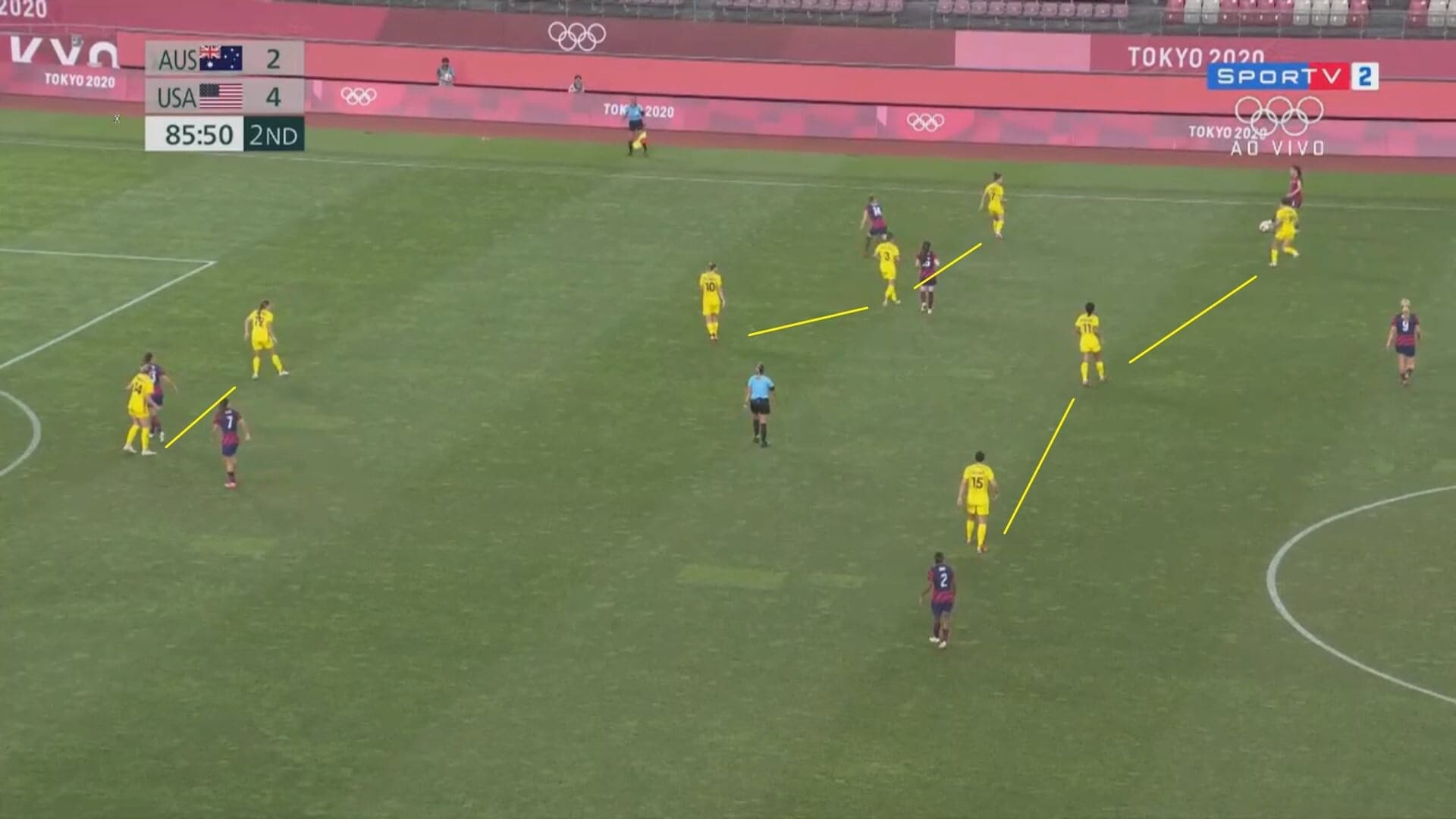
Defensively, they tried to limit the space that the USA had to play in, with this image showing how different players linked up to prevent the USA passing as freely as they did in the first half. Having two groups of players positioned near the ball here forces it to go sideways or backwards, so Australia have prevented a shot on goal. This has been further helped by two players marking Tobin Heath and fellow substitute Alex Morgan on the edge of the box, meaning that any balls played in their direction would likely be intercepted and cleared.
Australia won the second half 2-1, with the USA struggling to create chances once the Matildas had set up with this defensive shape. They had lost their first-half attacking presence once Press, Lloyd and Rapinoe had been taken off, but the fact that they only had one goal after half-time came down to Australia’s clever tactical adjustments, which helped them to get back into the game.
Australia’s errors
However, the reason that the USA ultimately won the bronze medal in this match was because of the mistakes made by Australia throughout the game. Nerves perhaps got to them at stages, as they knew the history they would be making by winning the game, and that led to a few moments of them looking unsure of themselves.
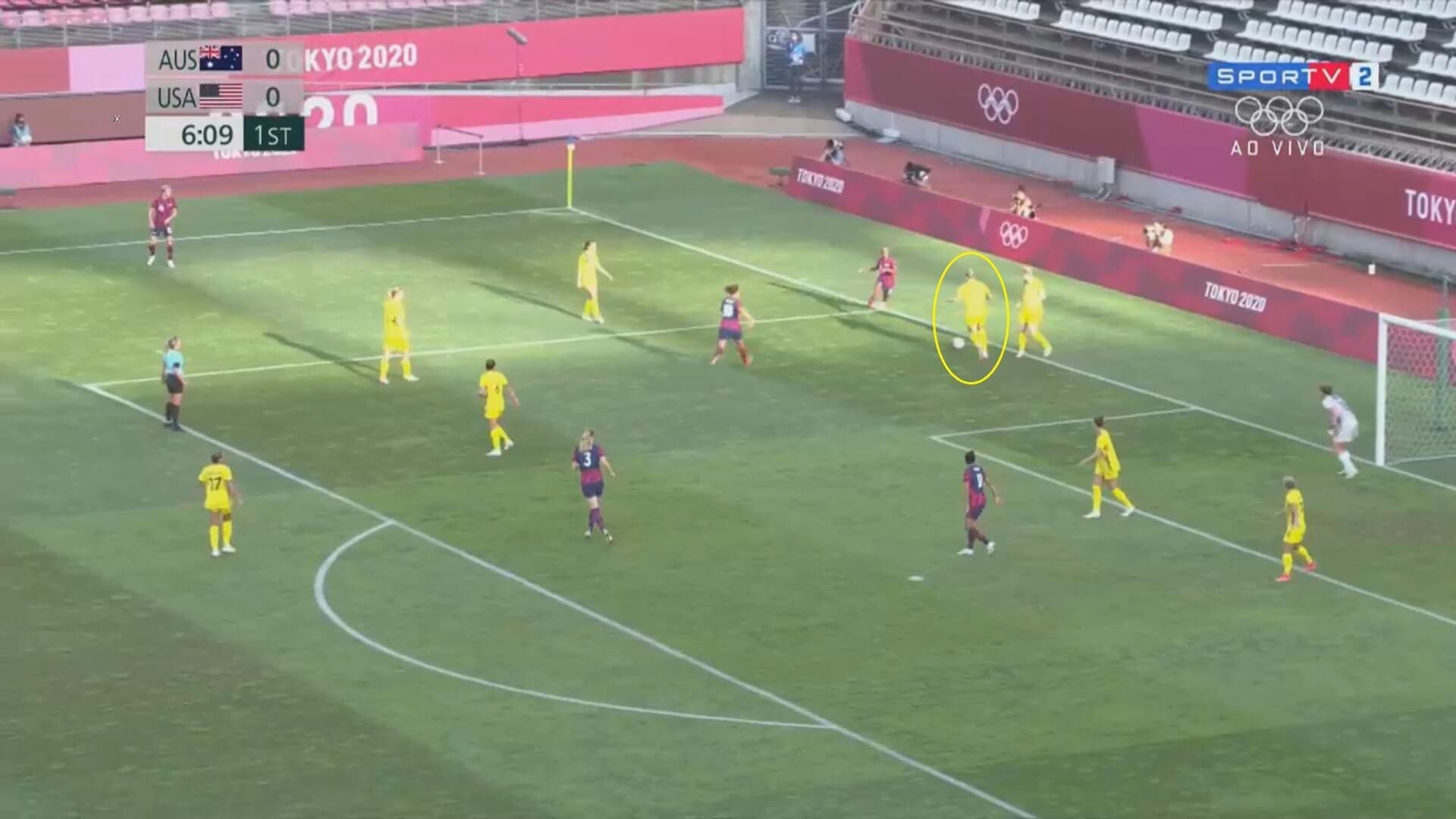
This is just one example of when they appeared to second-guess themselves, with Tottenham Hotspur Women defender Alanna Kennedy taking too many touches in her goal area, rather than trying to move the ball forward whilst there was space to do so. As a result, the USA have been allowed to come closer and surround her, and, against players like Rapinoe and Press, this nearly always results in defenders being punished. There were a few occasions where slow ball movement led to Australia conceding chances, so they needed to make quicker decisions and keep the ball moving in order to stop the USA winning it in dangerous positions.
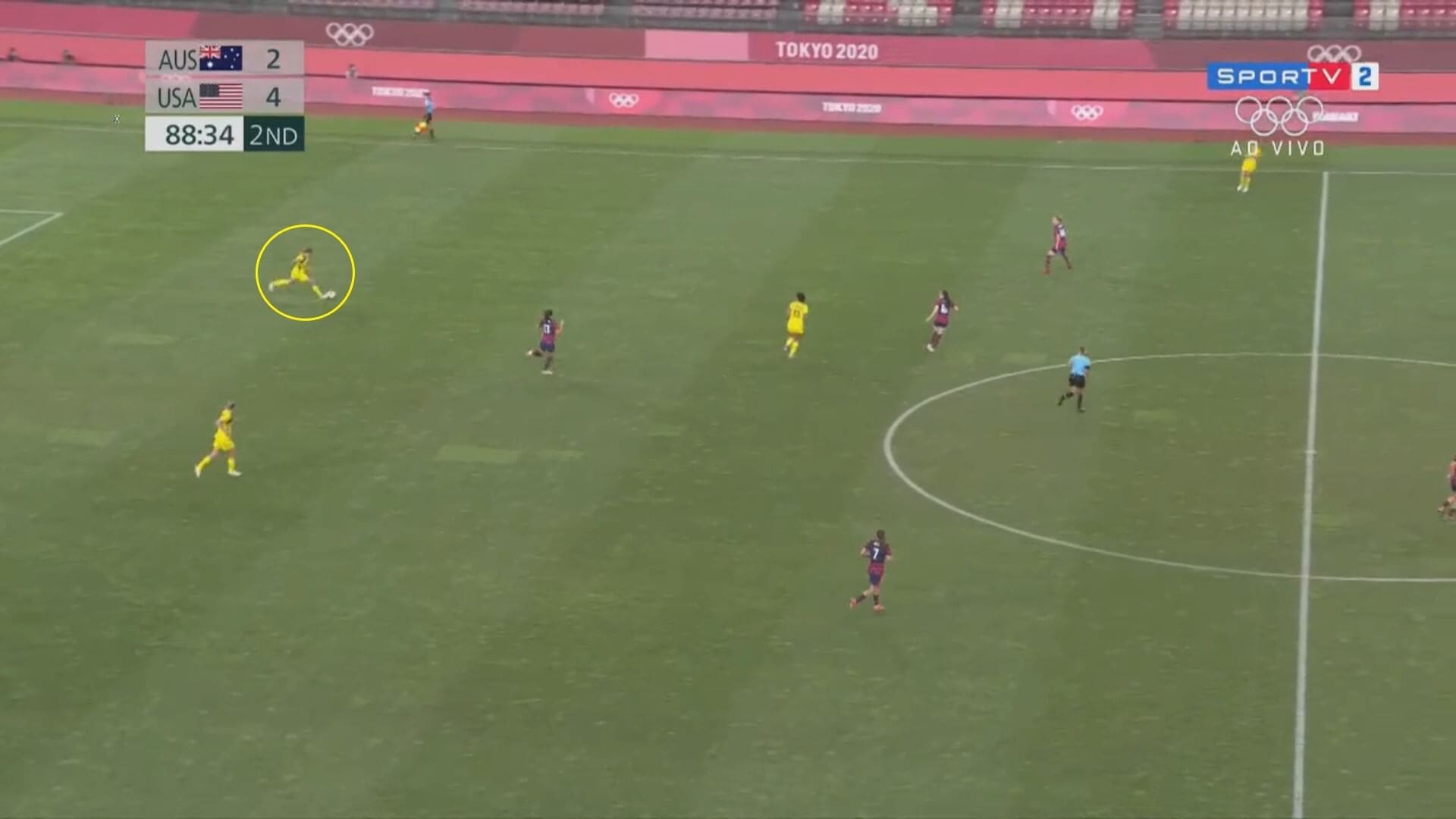
When they did have space to play out from the back, they tended to make aerial passes into the midfield, but this was where the USA could win the ball back with ease. Julie Ertz and Lindsey Horan, who were again in front of the defence and allowed to move around the pitch, were strong in the air, meaning that every clearance from Australia quickly came back at them. This was down to a lack of passing accuracy, which was something both sides were guilty of (we have already mentioned how the USA were still giving balls away too easily). Whilst there were some well-taken goals in this game, plenty of the chances that both sides created could be traced back to a mistake by their opponents, and the fact that some said afterwards that defending was “optional” in this game highlights that.
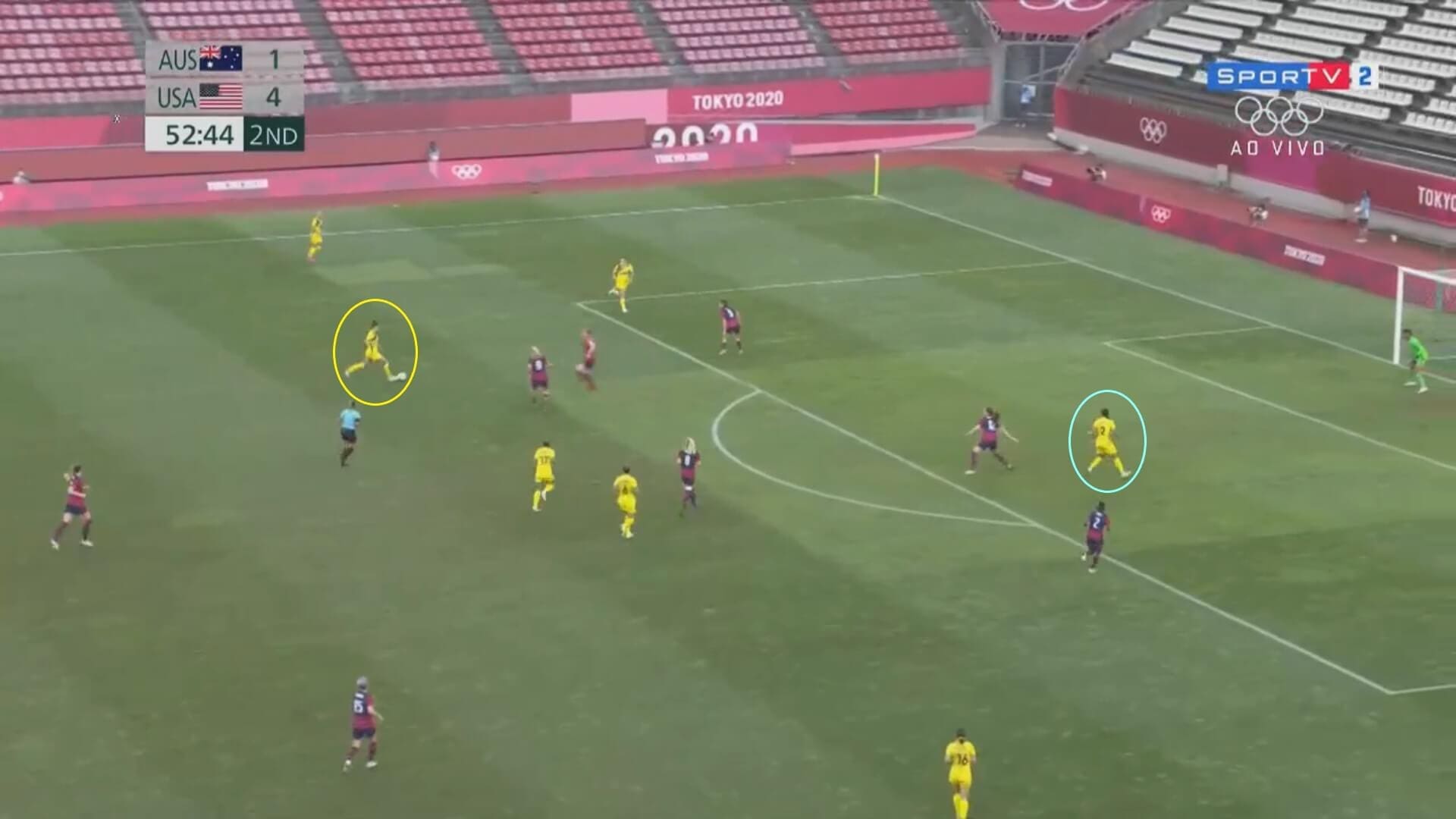
In attack, Australia also made mistakes that cost them when in good positions. There were a few occasions where they overran the defence and were caught offside, as Sam Kerr has been here. As a result, when the ball comes into the box from her teammate, in the yellow circle, Kerr has to let it go, and this again comes down to a general lack of accuracy. Australia could have scored a few more goals if they had made opportunities like this one count, and that will be playing on their minds now, given the final scoreline.
Conclusion
In conclusion, this tactical analysis has shown how the USA and Australia played out a lively and entertaining third-place match, with plenty on show tactically. The final scoreline of 4-3 correctly suggests that defending was not either team’s strong point in this game, and that is something that both teams will need to look at when analysing their own performances. Australia will see it as a victory to be competing for a medal, but the USA made no secret before the tournament began that they wanted to be challenging for the gold. However, Carli Lloyd said afterwards that the bronze medal win “qualified as success”, and, given their performances across the whole tournament, it is hard to disagree with her on that.





Comments